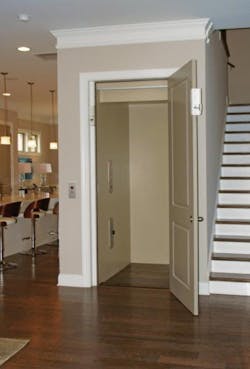In the Market for a Residential Elevator? Take a Look at These
As the Baby Boomer generation grows older and aging-in-place becomes an ever more popular option for homeowners, residential elevators are gaining in popularity. Manufacturers are stepping up to meet this growing demand.
According to the AARP, in 2014 87 percent of adults ages 65 and older and 71 percent of adults ages 50 to 64 wanted to stay in their current home and community as they aged. Many of these homes are multi-story, creating a problem as older individuals begin to have trouble with stairs. Elevator manufacturers have seen demand for their products rise accordingly.
READ: 13 PRODUCTS FOR A UNIVERSALLY DESIGNED HOME
“Especially in the past five years we've seen a growing trend of people wanting additional accessibility in their homes,” says Patrick de Ledebur, a sales and marketing specialist for Pneumatic Vacuum Elevators. “I don't think this trend will change; I think it will actually continue to grow. As more people age and as medicine and technology allow us to live longer, people who have already invested a lot of their own resources and money and even their lives and memories into a home want to stay in it.”
Beyond aging-in-place, Bruce Ramsay, marketing manager for Garaventa Lift, says he’s seeing elevators become more common as a luxury product, instead of a purely utilitarian necessity. In many cases, the luxury home market automatically builds homes according to universal design principles, so elevators are more often included even if the owners are far from needing them.
“As luxury homes are going into places where the land is very valuable… in a lot of neighborhoods [houses] are growing up,” Ramsay says. “People are putting [elevators] into their homes to plan for the future, or for the happenstance that somebody comes along, like an elderly relative, who may have difficulty using the stairs.”
From three-speed sliding doors to lifts powered by air and gravity, home elevator designs have come a long way. Here are five elevators that will increase accessibility in your homes.
Photo courtesy of Garaventa Lift
1. Garaventa Lift Elvoron In-Line Drive
Garaventa’s most popular model is the In-Line home elevator, since it eliminates the need for a machine room and hydraulic fluid. The controller box and battery backup can be mounted up to 50 feet away, and an 8-inch pit depth is recommended. Ramsay suggests pairing this model with the company's three-speed sliding premium door package, which works more like a typical commercial elevator door than old-fashioned, manually controlled residential accordion gates.
“Where I see the market going is with those three-speed sliding doors,” Ramsay says. “Our three-speed residential sliding doors are compact, they fit in an 8-foot overhead clearance, and they're cost effective.”
Photo courtesy of Pneumatic Vacuum Elevators
2. Pneumatic Vacuum Elevators PVE37
PVE is the only elevator company using air pressure and gravity to move people, de Ledebur says. An airtight shaft changes the pressure below and above the cab to raise it to up to five levels. It uses gravity and air pressure to lower the cab at a consistent rate, using almost no energy. The model requires no shaft, pit, or machine room (but does need to be installed on a finished and level floor), making it ideal for retrofits, de Ledebur says. The two-passenger model has a 37-inch diameter and a lift capacity of 450 pounds, and requires a 220-volt plug-in. All three of the PVE models, including one sized for wheelchairs, have panoramic views of the room around them.
“It consumes much less space than a traditional elevator,” says de Ledebur. “It's only 37 inches in diameter, so it can fit pretty much in any home or in any space that a person would need.”
Photo courtesy of Symmetry Elevating Solutions
3. Symmetry Elevating Solutions Inline Gear Drive
Symmetry’s inline system places the drive and motor controller at the top of the hoistway, eliminating the need for a separate machine room. The Inline Gear Drive saves energy compared to other drive systems, making it less expensive and more environmentally friendly, the company says. The lift comes equipped with long-lasting LED lighting. The standard model requires a minimum pit depth of 6 inches, has a 1,000-pound capacity, and can travel two stops for a maximum of 50 feet. The customizable cab comes with several door options and interior wood paneling in a range of finishes.
Photo courtesy of Inclinator
4. Inclinator Elevette 300 Cab
The Inclinator Elevette comes with one of three drive systems, including a machine-roomless drive that saves space. The company offers five cab styles, including the popular Cab 300 (shown) that includes smooth hardwood panels and crown molding in one of eight standard finishes or a custom finish. Controls and handrails are available in three metal finishes. Each drive system has a 1,000-pound capacity and can accommodate six landings. They feature ASME code-compliant customizable accordion gates.
5. Stiltz Duo Alta
The Duo Alta is a free-standing, self-supported elevator that can be placed nearly anywhere in a home. It runs using a discreet wire and a drive system housed at the top of the elevator that give it a sleek look from the outside. The Duo Alta takes up less than 7 square feet of space and leaves a sturdy, finished lid to cover holes on each floor, eliminating the need to hide it away in a closet. It can be powered by a standard 110- or 220-volt power outlet, helping it run quieter than other models, the company says.




